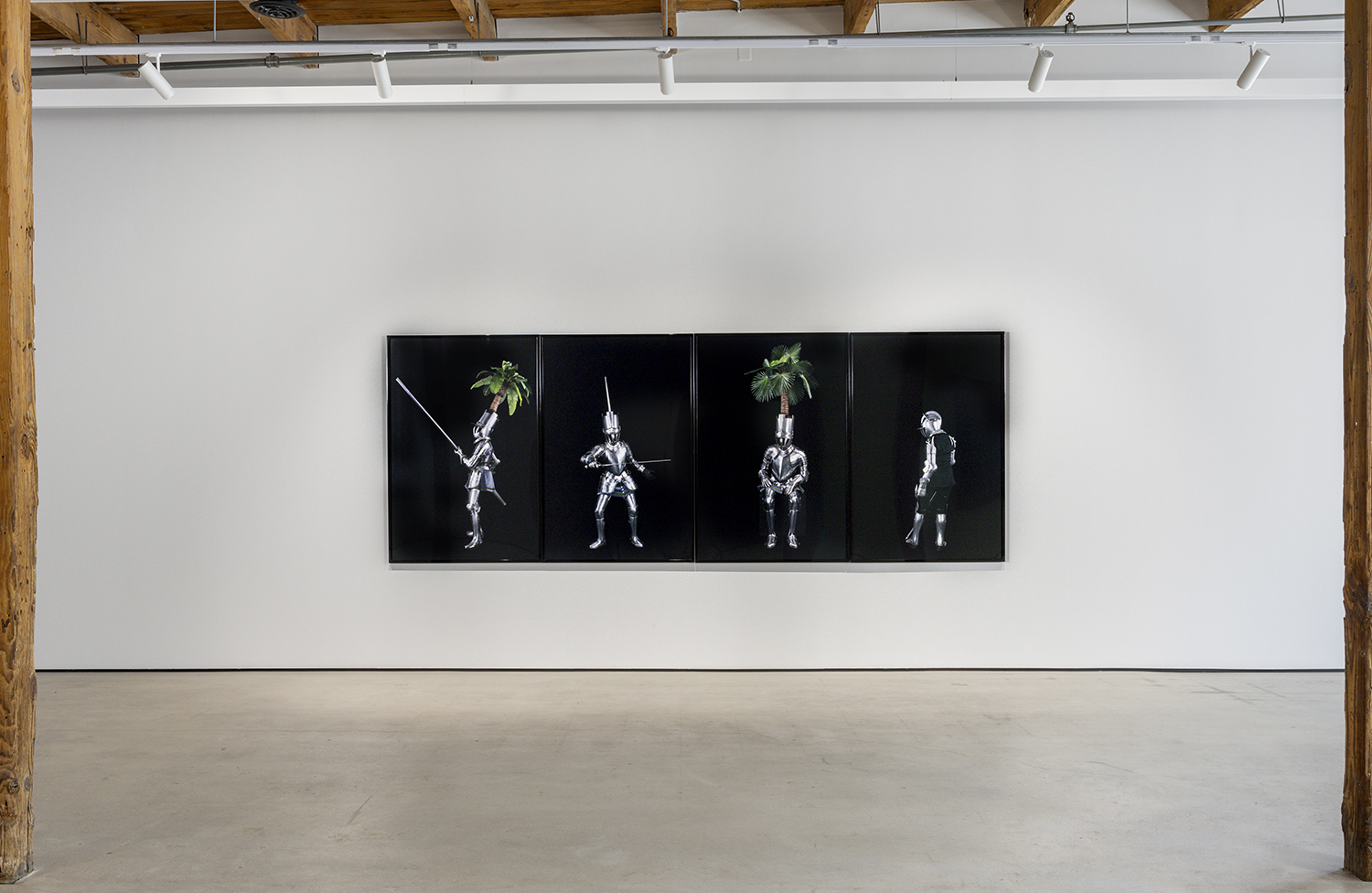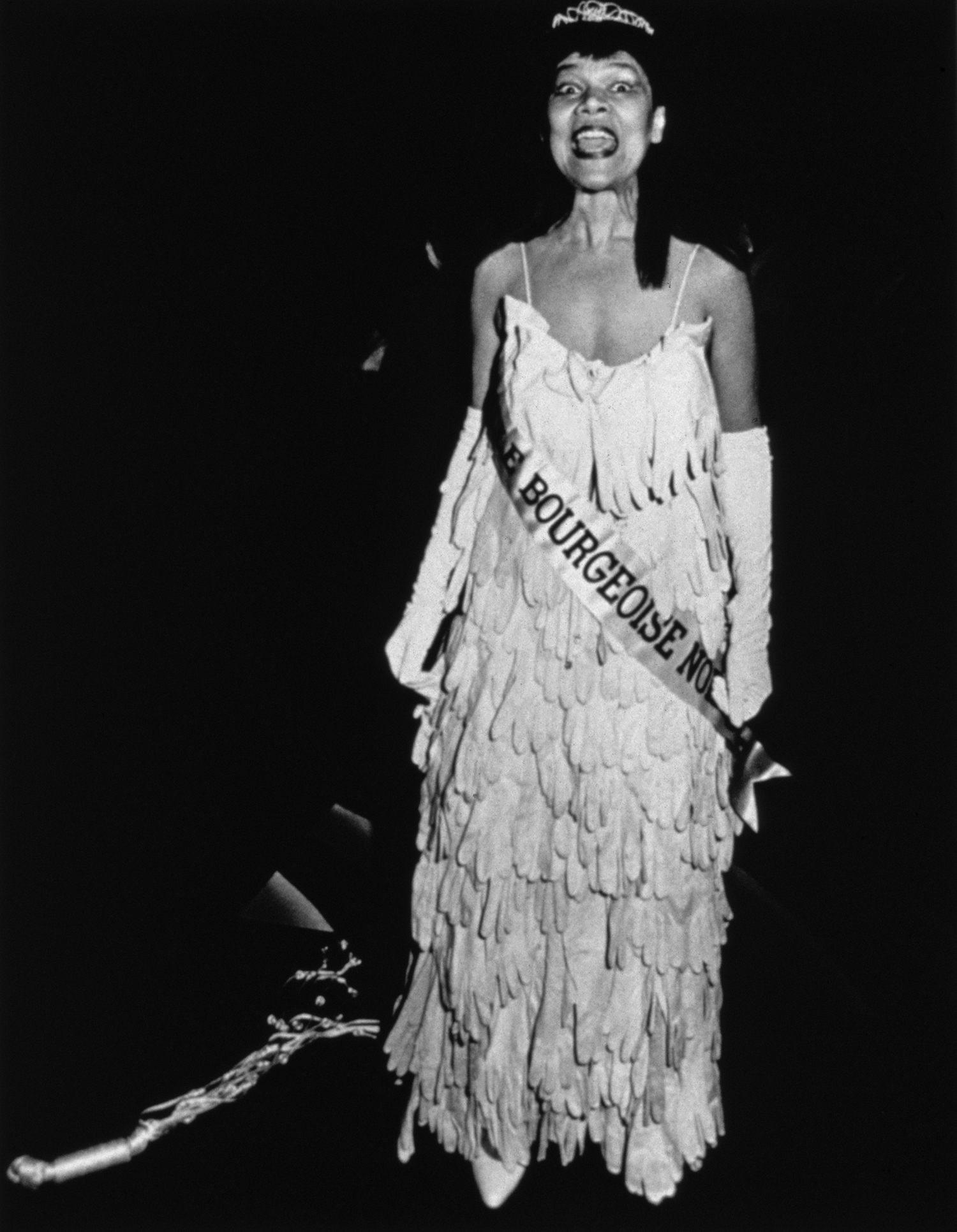Lorraine O’Grady: The Knight, or Lancela Palm-and-Steel
Catching the glint of Lorraine O’Grady’s eye through the grill of the heavy armor she wears as The Knight, or Lancela Palm-and-Steel, a new persona in her long-spanning career, is unsettling. In nearly life size portraits photographed austerely on black, the knight trapped in shining armor appears to go through studied exercises of preparation and readiness. To learn that O’Grady, at 89, had the suit of armor custom-forged, took lance and sword training, and wears the armor in the photographs gives insight into how deeply O’Grady inhabits the persona.
O’Grady’s work is self-exploration as well as cultural critique. Raised in Boston by West Indian born parents, the self and multiplicity as well as the diasporic experience are consistent themes. Hybridity—the “both/and” conceptual framework that O’Grady uses to subvert the Western philosophical insistence on “either/or”—carries through her work. A palm tree sprouts from the helmet of the early Renaissance style armor of the conquistadors. A family portrait of The Knight, alongside a toy horse, and a squire in carnival attire, call to mind the trio in Don Quixote. The Fir-Palm, from 1991 depicts a tree with a Caribbean palm trunk topped by a New England fir, growing from a torso.
O’Grady’s most well-known persona, Mlle Bourgeoise Noire (1980-83) appeared unannounced at public art events wearing a formal gown made of 180 pairs of white gloves carrying a flower-filled cat o’nine tails. Confronting gender, race and class, O’Grady described her performances as “a critique of the racial apartheid still prevailing in the mainstream art world.” Her appearance posed a subversive challenge.
Fifty years after Mlle Bourgeoise Noire’s appearance, O’Grady introduces the Knight, an anonymous and shielded avatar. She asks, “If you conceal everything—race, class, age, gender—what is left? What is possible?”

Installation of The Knight, or Lancela Palm-and-Steel at Mariane Ibrahim Chicago, 2024. Courtesy of the artist and Mariane Ibrahim.
A video of O’Grady speaking about her work at Mariane Ibrahim Chicago Gallery can be found here:
Lorraine O’Grady is a conceptual artist and cultural critic whose work over four decades has employed the diptych, or at least the diptych idea, as its primary form. While she has consistently addressed issues of diaspora, hybridity and black female subjectivity and has emphasized the formative roles these have played in the history of modernism, O’Grady also uses the diptych’s “both/and thinking” to frame her themes as symptoms of a larger problematic, that of the divisive and hierarchical either/or categories underpinning Western philosophy. In O’Grady’s works across various genres including text, photo-installation, video and performance, multiple emotions and ideas coexist. Personal and aesthetic attitudes often considered contradictory, such as anger and joy or classicism and surrealism, are not distinguished. Even technical means seem governed by both chance and obsessive control so as to express political argument and unapologetic beauty simultaneously. And across the whole, essays and images interpenetrate. While O’Grady’s diptychs are sometimes explicit, with two images side by side, at other times they are implicit, as when two types of hair—silk and tumbleweed, videotaped on the same scalp at different hours of the same day—alternate and interact to create permeating worlds. The goal of her diptychs is not to bring about a mythic “reconciliation of opposites,” but rather to enable or even force a conversation between dissimilars long enough to induce familiarity. For O’Grady, the diptych helps to image the kind of “both/and” or “miscegenated” thinking that may be needed to counter and destabilize the West’s either/or binary of “winners or losers,” one that is continuously birthing supremacies, from the intimate to the political, of which white supremacy may be only the most all-inclusive.
An early adopter of digital technology, O’Grady has also created a website, lorraineogrady.com, which is considered a model of the online abbreviated-archive, and her paper archive is in the collection of the Wellesley College Library. Among O’Grady’s writings, the 1992/94 long-form essay “Olympia’s Maid: Reclaiming Black Female Subjectivity” has proved an enduring contribution to the fields of art history and intersectional feminism and is now considered canonical. O’Grady’s art works have been acquired by, among other institutions, the Art Institute of Chicago. IL; Museum of Modern Art, NY; Tate Modern, London, UK; Museum of Fine Arts, Boston, MA; and the Whitney Museum of American Art, NY. O’Grady has been the subject of numerous one-person exhibits. Her retrospective, Lorraine O’Grady: Both/And, Brooklyn Museum (2021), traveled to the Weatherspoon Art Museum in Greensboro, NC (2022) and was re-staged at the Davis Museum of Wellesley College in 2024.
She is a recipient of a 2024 Guggenheim Fellowship. Her work is represented by Mariane Ibrahim Gallery.

Family Portrait 2 (Getting Dressed), 2020. Courtesy of the artist and Mariane Ibrahim. ©Lorraine O’Grady

Lilith Sends Out the Destroyers, 1991/2019. Courtesy of the artist and Mariane Ibrahim. ©Lorraine O’Grady

The Strange Taxi, From Africa to Jamaica to Boston in 200 Years, 1991/2019. Courtesy of the artist and Mariane Ibrahim. ©Lorraine O’Grady
Posts on Lenscratch may not be reproduced without the permission of the Lenscratch staff and the photographer.
Recommended
-
Nathan Bolton in Conversation with Douglas BreaultJanuary 3rd, 2026
-
Salua Ares: Absense as FormNovember 29th, 2025
-
Ricardo Miguel Hernández: When the memory turns to dust and Beyond PainNovember 28th, 2025
-
Pamela Landau Connolly: Columbus DriveNovember 26th, 2025































































